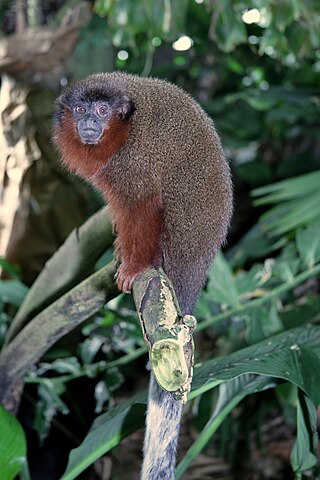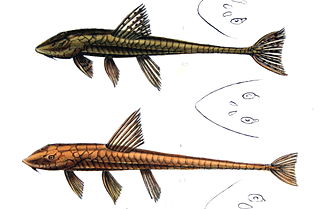
The brown titi monkey is a species of titi monkey, a type of New World monkey, from South America. It is endemic to Brazil. It was originally described as Callicebus brunneus in 1842 and transferred to the newly erected genus Plecturocebus in 2016.

The brown catshark is commonly found in the Pacific Ocean, ranging from the northern Pacific waters off the coast of British Columbia and south to the Baja California peninsula in Mexico. They may live as far south as Ecuador and Peru. Brown catsharks are deep-water sharks that live on the outer continental shelf and the upper slope. They have been known to live at depths ranging from 30 to 650 m and live on the bottom, usually in muddy or sandy areas. The brown catshark, when originally described, was called Catulus brunneus.

Loricariichthys is a genus of catfishes of the family Loricariidae.

The Asian red-eyed bulbul is a member of the bulbul family of passerine birds. It is found on the Malay Peninsula, Sumatra, and Borneo. Its natural habitat is subtropical or tropical moist lowland forests.

The black-tailed leaftosser is a species of bird in the subfamily Sclerurinae, the leaftossers and miners, of the ovenbird family Furnariidae. It is found in Bolivia, Brazil, Colombia, Ecuador, French Guiana, Guyana, Peru, Suriname, and Venezuela.

The Fernando Po speirops, also known as the Bioko speirops, is a species of bird in the family Zosteropidae. It is endemic to Bioko Island in Equatorial Guinea.

Lawrence's thrush is a species of bird in the family Turdidae. It is found in Bolivia, Brazil, Colombia, Ecuador, Peru, and Venezuela. Described in 1878 by George N. Lawrence as Turdus brunneus, a name that was already in use the species was therefore renamed as Turdus lawrencii by Elliott Coues in 1880. Its natural habitats are subtropical or tropical moist lowland forests and subtropical or tropical swamps.

The Vanikoro flying fox, also known locally as the basapine, is a species of bat in the family Pteropodidae. It has only been found in the Vanikoro island group located in the southern Solomon Islands. The species as a whole was originally known from just a few specimens collected sometime before 1930 but following surveys conducted on the island in the early 1990s did not detect this species again causing the Vanikoro flying fox to be listed as extinct. However, the species was rediscovered by a survey conducted in late 2014 which indicated a population in the high hundreds or low thousands and reported all observations.
Loricariichthys edentatus is a species of catfish in the family Loricariidae. It is native to South America, where it occurs in the lower Uruguay River basin in Entre Ríos Province in Argentina, and also in Brazil. It has no teeth on the premaxilla, a unique feature in the genus Loricariichthys. The species reaches 11.5 cm in standard length and is believed to be a facultative air-breather.

Humboldt's white-fronted capuchin is a species of gracile capuchin monkey. It is found in Colombia, Venezuela, Brazil, and potentially the island of Trinidad.

The brown weeper capuchin or Venezuelan brown capuchin is a species of gracile capuchin monkey endemic to Venezuela, although some sources also consider it to occur on Trinidad.

The Urubamba brown titi monkey is a species of titi monkey, a type of New World monkey, endemic to Peru.
Pseudancistrus yekuana is a species of catfish in the family Loricariidae.
Loricariichthys cashibo commonly called Carachama is a species of catfish in the family Loricariidae. It is endemic to Peru, where it occurs in the upper Amazon River basin. Its type locality is Lake Cashiboya. The species reaches 13 centimetres (5.1 in) in length and is believed to be a facultative air-breather.

Loricariichthys castaneus, the Cascudo-viola is a species of catfish in the family Loricariidae. It is endemic to Brazil, where it occurs in coastal streams in southeastern part of the country, ranging from São Paulo to Espírito Santo, including the Paraíba do Sul basin. The species reaches 39.6 centimetres (15.6 in) in total length and is believed to be a facultative air-breather.
Loricariichthys chanjoo, one of a number of Loricariichthys species commonly known as Shitari, is a species of catfish in the family Loricariidae. It is endemic to Peru, where it occurs in the Ucayali River basin, with its type locality being listed as Contamana. The species reaches 23 centimetres (9.1 in) in length and is believed to be a facultative air-breather.
Loricariichthys derbyi, commonly known as Cari, is a species of catfish in the family Loricariidae. It is endemic to Brazil, where it occurs in the Jaguaribe River basin. The species reaches 24.9 centimetres (9.8 in) in total length, can weigh up to at least 161 grams (5.7 oz), and is believed to be a facultative air-breather.
Loricariichthys hauxwelli, one of a number of Loricariichthys species commonly known as Shitari, is a species of catfish in the family Loricariidae. It is endemic to Peru, where it occurs in the Ampiyacu River basin. The species reaches 18 centimetres (7.1 in) in length and is believed to be a facultative air-breather.
Loricariichthys nudirostris is a species of catfish in the family Loricariidae. It is endemic to Brazil, where it occurs in the Amazon River basin. The species reaches 23.5 centimetres (9.3 in) in standard length, can weigh up to at least 89.6 grams (3.16 oz), and is believed to be a facultative air-breather.
Loricariichthys ucayalensis is a species of catfish in the family Loricariidae. It is native to South America, where it occurs in the Ucayali River basin, for which it is named, in the upper Amazon River drainage in Peru. The species reaches 22 centimetres (8.7 in) in total length and is believed to be a facultative air-breather.













